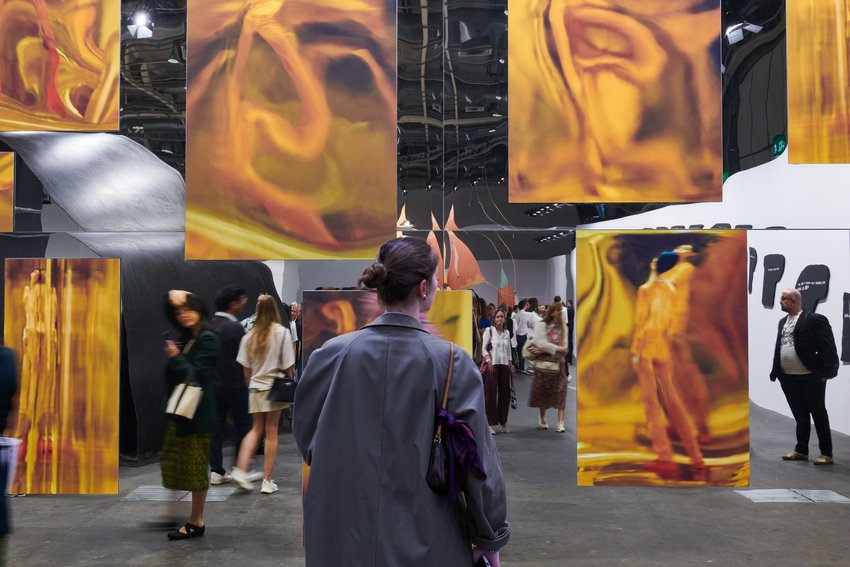

Get out your Acne Studios, A.W.A.K.E. Mode and Loewe. We’re going collecting. But don’t expect Krug-soaked whispers in a private viewing room. The ‘new collectors’ are digital natives, globally minded and more likely to acquire a piece through Instagram DMs than at a hushed gallery dinner. Most notably, they’re democratizing collecting altogether.
In my advisory practice, I’ve witnessed a quiet but radical revolution: a generation of collectors entering the art world not through legacy connections, but through digital platforms, shared values and a genuine desire to build meaningful, personal collections. Speculation and art world buzz aren’t the draw. For these new collectors, the appeal lies in building community and collecting with intention.
That’s not to say the traditional collector is gone. Plenty of clients still view art as a capital asset, concerned with portfolio diversification and the most coveted gallery dinner at Art Basel Miami Beach. (Who doesn’t love free stone crab?) Today, collecting is more an expression of identity than a performance of power.
From hedge funds to hashtags
There’s a fresh injection of energy—and capital—into the art market, and that’s a good thing. According to the 2024 Art Basel & UBS Survey of Global Collecting, millennials and Gen Z now lead the global market in both activity and growth. Millennials reported spending, on average, over $74,000 on paintings alone.
They’re startup founders, creative directors, climate-tech entrepreneurs—people who see art as a mirror of their values. Many are entering the market at more accessible price points between $5,000 and $25,000 and are seeking “jewel-box works”: intimate, small-scale pieces with visual and emotional impact. Size and hype matter less than substance and story. These collectors want art that speaks to themes like racial justice, personal identity, ecological consciousness and community care.
Where their predecessors inherited both wealth and taste, this generation is self-taught (with a little advisory guidance) and socially attuned. Their collections are actively reclaiming and reframing the canon.
Women leading the way
Among the most exciting shifts in this landscape is the rise of women collectors. Long sidelined in collecting circles, women are now shaping the future of the market. Women have shown that they are an “undeniably growing force” with an increased interest in collecting. Women artists account for 44 percent of artists in high-net-worth collections.
And women are spending more than men in their median expenditure. In our own advisory work, we recently tipped into a majority-female client base. And these women are leading with values, asking how they can support emerging women and BIPOC artists. Their collections tend to be more inclusive, often focused on historically underrepresented artists—especially women.
For example, collectors like Valeria Napoleone, who exclusively collect work by female-identifying artists, are setting a tone that’s quickly becoming the norm. More than just a moral correction, this is market-smart. Philanthropists like Pamela Joyner and Komal Shah are funding museum exhibitions, supporting scholarship and serving on boards where they influence institutional programming. Major institutions are actively expanding the works by women artists in their collections, and artists like Ruth Asawa, Olga de Amaral and Marlene Dumas are finally receiving long-overdue institutional and commercial recognition. Dumas’s $13.6 million sale at Christie’s this May set a new record for a living female artist.
Women collectors today aren’t just patrons—they’re tastemakers, philanthropists and institutional leaders. They’re taking leadership of museum boards, funding biennials and launching initiatives that shape culture from the top down.
The Great Wealth Transfer: new money, new mindsets
Central to this seismic shift is a staggering statistic: over $84 trillion in assets will transfer from baby boomers to their Gen X and millennial heirs by 2045. This Great Wealth Transfer is reshaping not only who collects, but how, and why.
This rising generation is digitally native, climate-conscious and skeptical of traditional hierarchies. They grew up with crowdfunding, NFTs and social media activism. Their approach to art buying is transparent, values-driven and often collaborative. Where previous generations asked, “What does this do for my collection portfolio?”, new collectors are more likely to ask, “What does this say about me?” Artists exploring identity, social equity and climate politics now dominate their walls—and their feeds.
Access and algorithms
If the gallery was once the gatekeeper, the algorithm is now the guide. According to Artsy’s 2024 Collector Insights Report, 82 percent of millennial and Gen Z collectors bought art online last year, with over half spending most of their budgets via digital platforms. Instagram plays a major role: 43 percent of collectors discovered works they later purchased on the app, according to the Art Basel and UBS report on HNWI collector behavior.
We often help clients curate not just their collections, but their social feeds. For these buyers, transparency is everything. If a listing reads “price upon request,” many will simply swipe left. Nearly 70 percent of younger collectors say a lack of visible pricing is a key barrier to entry. They expect open marketplaces, blockchain-tracked provenance and fair artist equity. If that’s not part of the offer, they’re not buying.
Cooler markets, warmer intentions
Yes, global art sales fell 12 percent in 2024, but for these collectors, a cooler market feels more like an invitation than a setback. With speculation cooling and access improving, thoughtful buyers are building collections with purpose.
Many are asking us to work directly with artists, estates, curators and scholars to assemble intentional, revisionist collections that reflect broader and more inclusive narratives. The question of “Will this go up in value?” has been replaced by: “Will this still mean something to me in ten years?”
The future is collecting
If the old art world was about proximity to power, the new one is about proximity to purpose. Instead of waiting for a seat at the table, today’s collectors are building their own. In doing so, they’re ushering in a more transparent, inclusive and emotionally resonant art economy.
This is not a trend. It’s a generational realignment. Women collectors, digital natives and new inheritors of wealth are redrawing the lines of taste, access and influence. Not only are the new collectors bringing new money into the art market, they’re bringing new meaning. And that, from where I sit, is one of the most valuable assets of all.











